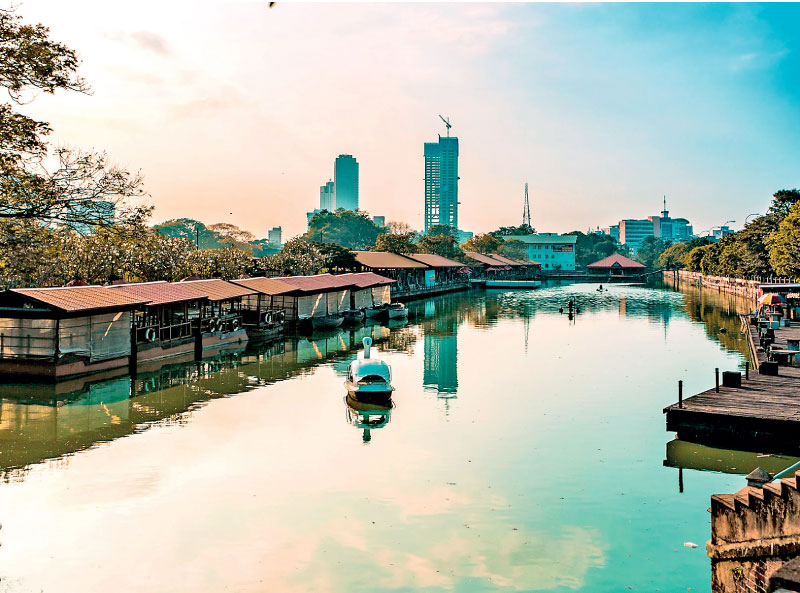Thursday Apr 03, 2025
Thursday Apr 03, 2025
Friday, 8 July 2022 00:16 - - {{hitsCtrl.values.hits}}

Cities can reduce emissions and help mitigate climate change as well as enhance the adaptive capacities of billions of people
 Today, the majority of the world’s population lives in cities. Urban areas are currently home to 4.2 billion people, and urban populations expected to grow by an additional 2.5 billion people by 2050. All regions of the world are expected to urbanise throughout the next decades, but urbanisation is likely to be faster and include larger numbers of people in developing countries, particularly in the African and Asian region. South Asia, to which Sri Lanka belongs, is projected to be the second most rapidly urbanising region in the world behind Sub-Saharan Africa.
Today, the majority of the world’s population lives in cities. Urban areas are currently home to 4.2 billion people, and urban populations expected to grow by an additional 2.5 billion people by 2050. All regions of the world are expected to urbanise throughout the next decades, but urbanisation is likely to be faster and include larger numbers of people in developing countries, particularly in the African and Asian region. South Asia, to which Sri Lanka belongs, is projected to be the second most rapidly urbanising region in the world behind Sub-Saharan Africa.
As centres of population and human activity, cities are responsible for more than two-thirds of global greenhouse gas emissions, which makes them critical contributors to climate change. For this reason, shaping the future of cities is central to solving the global climate crisis as well as to address biodiversity loss and the need for poverty reduction and sustainable development. Cities can reduce emissions and help mitigate climate change—for example through their infrastructure, the transport sector, buildings, energy usage, commercial activity, industry etc.—, but they can also enhance adaptive capacities of billions of people by providing them with the tools and enabling environment to better withstand climate change.
Cities as climate hotspots
Urban areas are potential catalysts for climate action, but they are also exposed and vulnerable to climate-related hazards and a multitude of short- and long-term impacts. For example, heat waves and heat stress, heavy rains, floods, storms, wildfires, and high winds already threaten cities around the world, while long-term processes such as sea level rise or water scarcity are expected to further affect urban areas throughout the 21st century.
This interconnection between cities and climate change is increasingly acknowledged in scientific literature and key global reports. For instance, climate change is prominently featured in the World Cities Report 2022 published by UN-Habitat, while the Intergovernmental Panel on Climate Change (IPCC) has dedicated a separate chapter on cities and human settlements in its latest assessment report (AR6).
The IPCC report highlights that “in all cities and urban areas, the risk faced by people and assets from hazards associated with climate change has increased,” disrupting infrastructure and essential services as well as the links between urban, peri-urban, and rural areas. The IPCC report outlines that globally, “the most rapid growth in urban vulnerability and exposure has been in cities and settlements where adaptive capacity is limited—especially in unplanned and informal settlements in low- and middle-income nations and in smaller and medium-sized urban centres.”
How cities manage these growing climate risks and protect especially their most vulnerable population groups will make a crucial difference going forward. Factors such as governance capacity, financial support, awareness, and available technology play a role for this response, but also social and cultural factors, skill-building, entrepreneurship, welcoming migrants, dealing with legacy infrastructure and its constraints, harnessing innovation, and integrating natural ecosystems into urban planning and development.
Merging urban and natural ecosystems
Urban areas can be seen as artificial ecosystems of their own which are characterized by complex systems of human interaction, employment, supply and value chains, markets, infrastructure, services, transport, communication, sanitation, water management, food provision, storage, and many other elements. However, they are also connected to the natural environment and non-human ecosystems, for example forests, urban wetlands, rivers and estuaries, lakes, beaches, or parks.
These ecosystems provide a multitude of services that can make a key difference in quality of life, human wellbeing, and climate or disaster risk reduction. For one, air and water quality can be significantly improved by wetlands, trees, and green spaces inside an urban area. Furthermore, natural ecosystems can provide provisioning services, regulate other aspects of the environment, and serve as sites for recreational activities or tourism. They also have the potential to protect human communities, infrastructure, and assets from disaster events and unexpected shocks—such as floods or storms—and reduce coastal erosion and land degradation. Finally, they can also serve as habitats for biodiversity and urban wildlife, especially in tropical countries such as Sri Lanka.
The IPCC report refers to evidence from cities around the world, including Colombo, on the effectiveness of risk reduction through zoning and land use to “protect and expand green infrastructure and soft land cover to alleviate pluvial flooding and decrease the urban heat island effect.” This highlights the fact that green infrastructure offers many benefits and can make cities not only more liveable and beautiful, but also safer and more prosperous.
Building resilient and adaptative cities
In contexts of crisis and difficulty, cities have the potential to turn into engines of growth and recovery. They offer a way for people to come together, connect, and engage in collective efforts that can reap social, economic, and environmental benefits if planned and managed properly. Cities can breed innovation and climate solutions, including nature-based solutions and “grey” infrastructure, but also solutions related to start-up ecosystems, education opportunities, frontier technologies, and capacity-building.
Cities tend to attract migrants from rural areas, but these migrants often end up settling into informal and unplanned ways that expose them to climate, health, and security risks. However, if migrants can be integrated into the fabric of the urban centre—with access to infrastructure, services, utilities, social protection, employment, and skills development—, they have the potential to enhance adaptation by making economic, social, and cultural contributions and strengthen rural-urban linkages that can make the entire region more resilient.
Transforming cities to become more climate-resilient and adapt to the current and projected impacts of climate change presents a key challenge for the 21st century. Climate-related disasters and long-term impacts will put millions at risk, including the most vulnerable population groups. However, if cities incorporate the range of available solutions into urban planning processes and focus on sustainable, climate-smart, and resilient development pathways, they can turn this challenge into an opportunity and thrive in the age of climate change.
(The writer works as Director – Research and Knowledge Management at SLYCAN Trust, a non-profit think tank based in Sri Lanka. His work focuses on climate change, adaptation, resilience, ecosystem conservation, just transition, human mobility, and a range of related issues. He holds a Master’s degree in Education from the University of Cologne, Germany and is a regular writer to several international and local media outlets.)
Discover Kapruka, the leading online shopping platform in Sri Lanka, where you can conveniently send Gifts and Flowers to your loved ones for any event including Valentine ’s Day. Explore a wide range of popular Shopping Categories on Kapruka, including Toys, Groceries, Electronics, Birthday Cakes, Fruits, Chocolates, Flower Bouquets, Clothing, Watches, Lingerie, Gift Sets and Jewellery. Also if you’re interested in selling with Kapruka, Partner Central by Kapruka is the best solution to start with. Moreover, through Kapruka Global Shop, you can also enjoy the convenience of purchasing products from renowned platforms like Amazon and eBay and have them delivered to Sri Lanka.
Discover Kapruka, the leading online shopping platform in Sri Lanka, where you can conveniently send Gifts and Flowers to your loved ones for any event including Valentine ’s Day. Explore a wide range of popular Shopping Categories on Kapruka, including Toys, Groceries, Electronics, Birthday Cakes, Fruits, Chocolates, Flower Bouquets, Clothing, Watches, Lingerie, Gift Sets and Jewellery. Also if you’re interested in selling with Kapruka, Partner Central by Kapruka is the best solution to start with. Moreover, through Kapruka Global Shop, you can also enjoy the convenience of purchasing products from renowned platforms like Amazon and eBay and have them delivered to Sri Lanka.